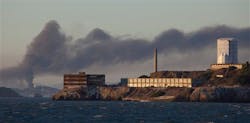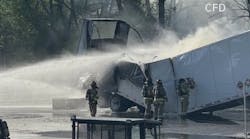SAN FRANCISCO, Calif. -- The Bay Area air pollution board said Monday it will expand its system of air monitors near oil refineries to detect smoke and fumes that were largely missed in the Aug. 8 Chevron refinery fire in Richmond.
"People have a right to know what's in the air they breathe," said John Gioia, a Contra Costa County supervisor and chairman of the nine-county air board.
The extra monitors should be able to pick up routine long-term pollution as well as toxic releases during emergencies, or during accidental releases, members of the Bay Area Air Quality Management District board said.
Everything from portable sniffing machines to balloon monitors that could be released into smoke plumes will be evaluated, agency managers said at a meeting attended by dozens of West Country Costa residents and environmental leaders.
"We need an expanded monitoring system to know what's in the air after incidents like this," said Gioia, of Richmond.
Gioia said refineries will pay for the new monitors.
Air district board members said they will examine options for new monitoring devices as they create a new rule to regulate what pollution information refineries will be required to collect and report to the public.
The air district had been scheduled to take more than a year to come up with the rule. In the wake of the Chevron fire, the air district now intends to enact the rule in 2013, said Jack Broadbent, the district's executive
director.
After the Chevron fire, more than 15,200 people visited hospitals with complaints of lung, eye and throat irritation and headaches and dizziness.
Because the smoke went up 1,000 to 5,000 feet in the air and then dispersed, air pollution monitors in West Contra Costa failed to detect any big jump in smoke particles, air district officials said.
The district has about 40 fixed pollution monitors, including eight that monitor for fine soot particles -- the pollutants suspected of causing the most health problems after the fire.
The air board will investigate the latest technology for portable soot monitors, but they are not as reliable as portable monitors for gaseous pollutants, said Eric Stevenson, the district's director of technical services.
It's not enough to get some pollution data, but rather results that can be quickly analyzed, understood and communicated to the public, Stevenson said.
Several environmental leaders said the air district has dragged its feet for years, talking about better monitoring, but the talk dies after memories fade of the latest incident.
"We need to have something real this time," said Henry Clarke, executive director of the West Contra Costa Toxics Coalition.
Denny Larson of Global Community Watch based in El Cerrito said the air district has balked at adopting "21st century technology" to monitor refineries.
"Things are about to change," because of the Chevron fire, Larson said.
Copyright 2012 - Contra Costa Times
McClatchy-Tribune News Service






